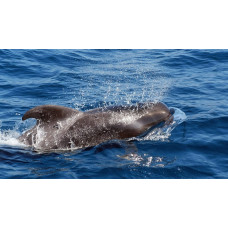Latin name
Globicephala macrorhynchus
Other names
North Pacific pilot whale, Pacific Pilot Whale.
Identification
The short-finned pilot whale is very different in appearance from the long-finned pilot whale. They have shorter fins, fewer teeth (14 to 18) on each jaw, and a different coloration. Their head is described as having a convex forehead, for which they are nicknamed melon-headed. They have a beak-shaped snout and thin, pointed fins.
Features of fish fins
As the name implies, the fins of the short-finned pilot whale are shorter than those of the long-finned pilot whale and have the shape of a rounded curve along the edges. The dorsal fins of males and females differ slightly in shape.
Fish colouring
The coloration is black or dark gray, the muzzle is gray or white. The belly and throat often have gray or nearly white patches, and the muzzle has gray or white stripes running diagonally upward above each eye.
Distribution
Native to the Atlantic, Pacific and Indian Oceans. Documented populations are found off the coasts of Japan, Spain, Africa, California, India and Hawaii. They prefer tropical and subtropical waters and do not reside in colder water areas such as the Arctic Ocean. In the Atlantic Ocean, they are found as far north as the island of Madeira and the Strait of Gibraltar, which is an upper limit of 50 degrees north latitude and a lower limit of 40 degrees south latitude.
Habitat
Whales live in deep, open waters near continental shelves and coastal areas. They prefer tropical and subtropical waters and can be found at depths of up to 609 meters.
Size
Adults can reach 3.5-6.5 meters in length. At birth they are 1.4-1.9 meters long. Weight at birth is about 60 kilograms, in adult individuals - from 1 to 4 tons. Average life expectancy of males is 45 years, females - up to 60 years.
Behavior
They are nomadic and social animals with a predominantly nocturnal lifestyle. Females form cohesive herds, while males migrate from herd to herd. Within a pod, older females do not participate in reproduction. During the day, short-finned pilot whales rest or migrate and do little socializing. At night, when they are feeding, they are more active and social. The whales travel long distances in constant search for food.
Food and feeding habits
Short-finned pilot whales follow schools of cephalopods (Cephalopoda), which are their main food source, and linger in areas with good habitat for their prey. These dolphins also eat small fish. They consume approximately 45 kilograms of food per day. At dawn and dusk, they make deep dives of up to 600 meters in search of food. These deep foraging dives are thought to occur when benthic prey rises and falls in the water column due to changes in sunlight.
Reproduction
Can breed year round, but breeding peaks in July-August. In addition, mating is not usually observed during the winter months. Both males and females have multiple mates. Females will mate with males outside their herd that move between herds. Young males disperse soon after weaning, while young females remain with the mother brood.
Fishing
Humans hunt these whales for food, to turn fat into oil, and to make bone jewelry and tools. Hunting of this species is now prohibited in some places.
Relationship with a person
Not suitable for home aquariums.
| Classification | |
| Phylum | Chordata |
| Class | Mammalia |
| Squad | Artiodactyla |
| Family | Delphinidae |
| Genus | Globicephala |
| Species | G. macrorhynchus |
| Features | |
| Conservation status | Least Concern |
| Habitat | Pelagic |
| Life span, years | 60 |
| Maximum body weight, kg | 4000 |
| Maximum length, cm | 650 |
| Sailing speed, m/s | No information |
| Threat to people | Edible |
| Way of eating | Predator |
Short-finned pilot whale
Tags: short finned pilot whale

